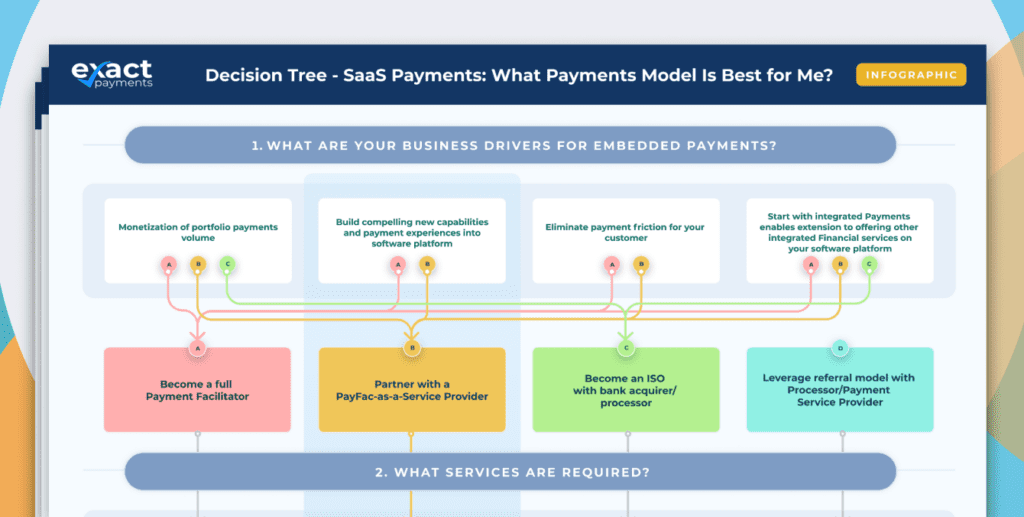ISO vs Payfac: Choosing the Right Payment Solution for Your Business

What is an ISO vs PayFac? Independent sales organizations (ISOs) and payment facilitators (PayFacs) play important intermediary roles in the payments ecosystem. Though they seem similar on the surface, there are key differences in how they operate. For starters, ISOs function only as resellers. They are agents of the banks and therefore only sell merchant accounts issued by processors and/or acquiring banks—they can’t issue merchant accounts on their own. In almost all cases, ISOs are “hands-off” in that they aren’t directly involved in the process outside of actually accepting card data and processing payments.
A payment facilitator, on the other hand, is actively involved in the payment process (hence the name “facilitator”). PayFacs also handle underwriting, onboarding, settlements, reporting, and chargebacks, along with payment processing. They are essentially mini-payment processors.
Independent sales organizations (ISOs) and payment facilitators (PayFacs) both act as intermediaries between merchants and payment processors, making them parallel channels in the overall payments ecosystem. However, despite their high-level similarities, there are some major operational differences between how ISOs and PayFacs operate. These include the responsibilities they carry out, their relationships with payment processors, the risk they take on, the technology they utilize, and more. The differences are important to understand, both for merchants looking to engage a partner for processing services, and for new entrants to the payments industry trying to decide which organizational form is right for them.
What is an ISO?
An ISO is an intermediary entity that resells and markets payment processing services on behalf of banks and payment processors. ISOs function primarily as sales agents or resellers. They set up merchant accounts and facilitate payment acceptance, but do not actually process or manage transactions themselves.
Once a merchant is signed up through an ISO, their application and account information is passed on to the bank or payment processor that the ISO partners with. The processor then handles setting up the technical payment acceptance, underwriting the account, managing risk, processing transactions, and settling funds.
ISOs act as a sales channel for banks and processors to expand their reach, especially to small or niche merchants that may be more complex for banks to take on directly. ISOs provide the customer service layer on top of the back-end processing. This allows processors to focus on managing transactions and infrastructure while ISOs handle acquisition.
What is a PayFac?
A PayFac provides payment processing services to merchants and small businesses. Unlike an ISO which only resells accounts, a PayFac takes an active role in managing transactions from end-to-end.
A PayFac partners with an acquiring bank and processor and becomes registered as a payment facilitator to gain access to card network processing capabilities. The bank provides the PayFac with a master merchant account. The PayFac then onboards sub-merchants under its umbrella. Rather than having to apply individually to the bank, small merchants can easily gain payment acceptance through the PayFac.
The PayFac conducts risk underwriting for each sub-merchant during onboarding. Once approved, the sub-merchant can process payments using the PayFac’s payment gateway and infrastructure while remaining aggregated under the master merchant account. This simplifies the process for small merchants by avoiding the need for individual accounts.
In essence, the PayFac serves as the merchant account provider for its sub-merchants. It assumes liability for losses or non-compliance. The PayFac is also responsible for handling chargebacks and providing support. By owning these operational components, PayFacs offer a more unified experience than ISO resellers.
ISO Versus PayFac: Key Differences
- Contracts: Another distinction between PayFacs and ISOs is contracts. A PayFac enters into a direct contractual relationship with its merchants (with or without a processor as part of the contract). An ISO can’t enter into this type of agreement. Instead, it must include the payment processor in its contract. In fact, most ISOs remove themselves from the contract altogether.
- Onboarding: When it comes to onboarding, PayFacs and ISOs are completely different. PayFacs manage the entire application and onboarding process, including underwriting for each merchant. They also handle most of the PCI compliance requirements. After an ISO signs on a merchant, they pass the merchant to a payment processor, and it’s the processor that actually handles the merchant onboarding.
- Risk: PayFacs take on more risk as they play a larger role in the payment process (i.e. underwriting and compliance). ISOs, on the other hand, have no risk exposure as they refer customers to a processor. Therefore, it’s the payment processor that assumes the risk in an ISO/merchant relationship.
- Processor Relationships: ISOs have relationships with a large number of processors so that they can offer their customers more choices and flexibility.PayFacs usually only have a relationship with one or two processors). This makes integration simpler for the PayFac when onboarding merchants, but it also can have other benefits from having an exclusive relationship with a single processor.
- Technology: PayFacs categorically provide better infrastructure to their clients. This is because PayFacs need to develop in-house tech solutions and systems for merchant onboarding, whereas ISOs provide merchants with the ability to process payments and they rely on a payment processor’s tech. PayFacs build payment APIs that allow merchants to integrate payments into the platform, they build the payment gateway that’s responsible for tokenization and secure transmission of card data, and the tech behind such features as reporting and merchant onboarding. Essentially PayFacs can provide a tailored experience that fits better for their customers whereas ISO customers are using a generic technical solution from their payment processor.
- Payment Distribution or Merchant Funding and Settlement: A merchant will receive funds, regardless of whether they use an ISO or a PayFac for payment processing. The distinction is how the funds are treated behind the scenes. PayFacs pay merchants directly and can often process payments faster, whereas ISOs don’t touch any money directly. Instead, the money is passed from the processor to the merchant’s account. The most significant difference when it comes to merchant funding is visibility into settlements. PayFacs offer customers much greater visibility into settlements compared to ISOs because an ISO’s settlement reporting is provided via the processor and only shows bulk settlement amounts. PayFacs can provide details down to the transaction level.
ISO Versus PayFac Cheat Sheet
| ISO | PayFac | |
| Contracts | No direct merchant contract | Direct contracts with all parties |
| Onboarding | Outsourced to processor | Managed in-house |
| Risk | No liability | Assumes risk |
| Processor Relationships | Many | One or two |
| Technology | Uses processor’s tech | Builds own tech |
| Funding, Settlement/ Payment Distribution | Direct to merchant | PayFac disburses |
Frequently Asked Questions About ISO Versus PayFac
Q: What are the main benefits of an ISO model?
A: Lower startup costs, leveraging existing processor relationships, quicker time to market.
Q: What are the disadvantages of an ISO?
A: Less control, lower revenue potential, limited capabilities.
Q: What are the advantages of a PayFac model?
A: Owning the full merchant lifecycle, higher revenue share, customization.
Q: What are the main challenges with a PayFac model?
A: Large upfront investment, assuming risk liability, more operational overhead.
Q: Is an ISO a PayFac?
A: While ISOs and PayFacs appear similar on the surface, they’re very different. ISOs function primarily as middlemen in the payments world, offering payment processing, while PayFacs are payment facilitation partners to their clients.
Q: Which points should I consider when evaluating an ISO versus a PayFac?
A: Evaluate your payment partner along the following points; technology, contracts, fees, security, risk, operations, ease of setup and onboarding, and support.



